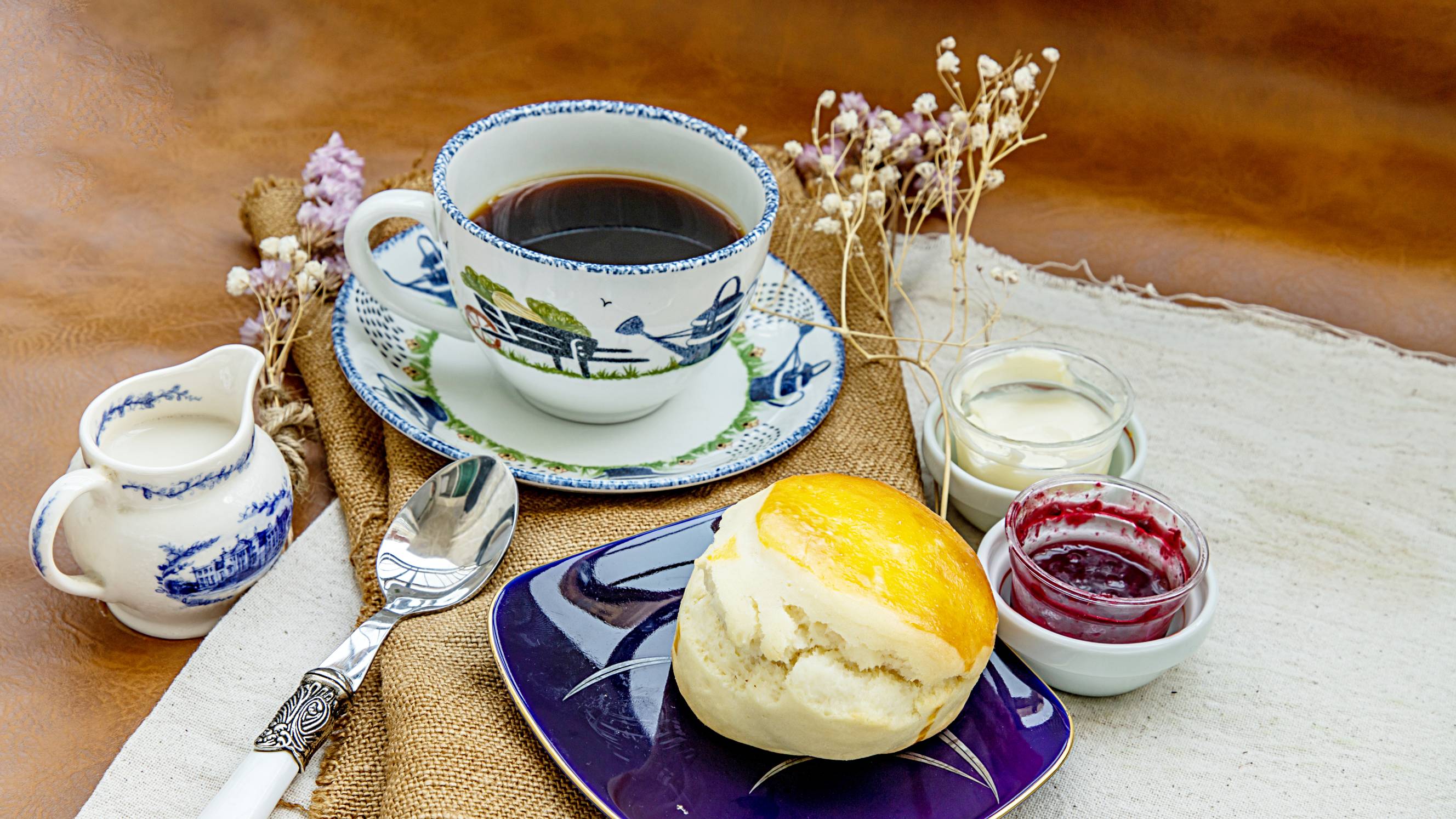
- Home/
- Comparisons/
- Dessert Delivery/
- Devon vs Cornwall Cream Tea
Devon vs Cornwall cream tea: How are they different?
Comparing Devon and Cornwall cream tea based on scone type, topping order, and more
Published on
Key Facts
- Devon cream tea is a light afternoon meal that comprises scones, clotted cream, and jam served with tea. The Devon method involves spreading cream on a piece of scone before topping it off with jam.
- Cornwall cream tea is also an afternoon snack composed of tea, scones, jam, and clotted cream. Cornish tradition dictates spreading jam on a scone before slathering a dollop of clotted cream.
The cream tea tradition involves several rules of etiquette. Navigating them for the first time can leave you flustered, and not knowing county-specific customs can lead to blunders. To learn about a particular divide that spells the difference between Devon vs Cornwall cream tea, you may read this article on these two types of traditional afternoon meals.
What is Devon cream tea?
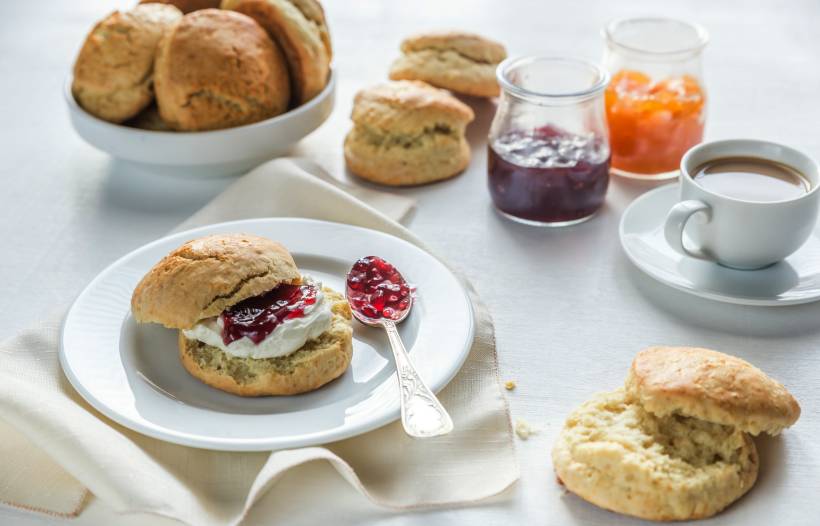
Devon cream tea, as evident in its name, is a traditional afternoon snack originating from Devonshire. This meal consists of tea, scones, clotted cream, and jam (usually strawberry). A distinct characteristic of Devon cream teas involves the topping order of the scone spreads, with jam going on top of clotted cream.
What is Cornwall cream tea?
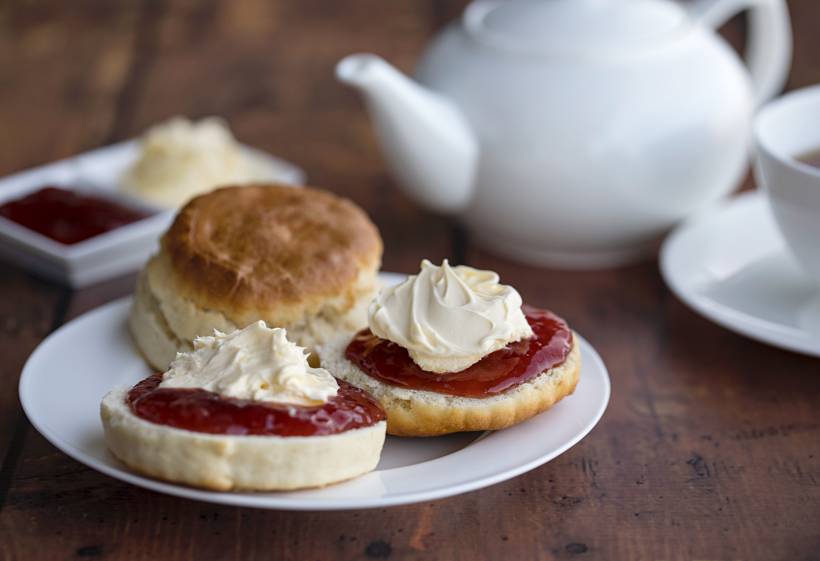
Cornwall cream tea, also known as Cornish cream tea, is another type of British afternoon meal traditionally served with scones, jam, clotted cream, and tea. When partaking in Cornish cream teas, a rule commonly observed is adding jam to a scone before spreading a layer of cream on top.
Devon vs Cornwall cream tea: What’s the difference?
The difference between Devon and Cornwall cream tea may not be crystal clear at first glance, but each type has distinctive traits that separate it from the other. The following list discusses their characteristics to help you tell them apart and choose the best cream tea in line with your personal preference.
In terms of scone type
Eating bread in the form of freshly baked scones is one of the main elements in Cornish and Devon cream teas. These baked goods are typically made with buttermilk, but there is a denser quality to the Devon vs Cornish scone.
Splits—both counties have their own varieties—may also be consumed in lieu of or in addition to scones. Do note that, compared to scones, both traditional Cornish and Devon splits are lighter and slightly sweeter.
In terms of topping order
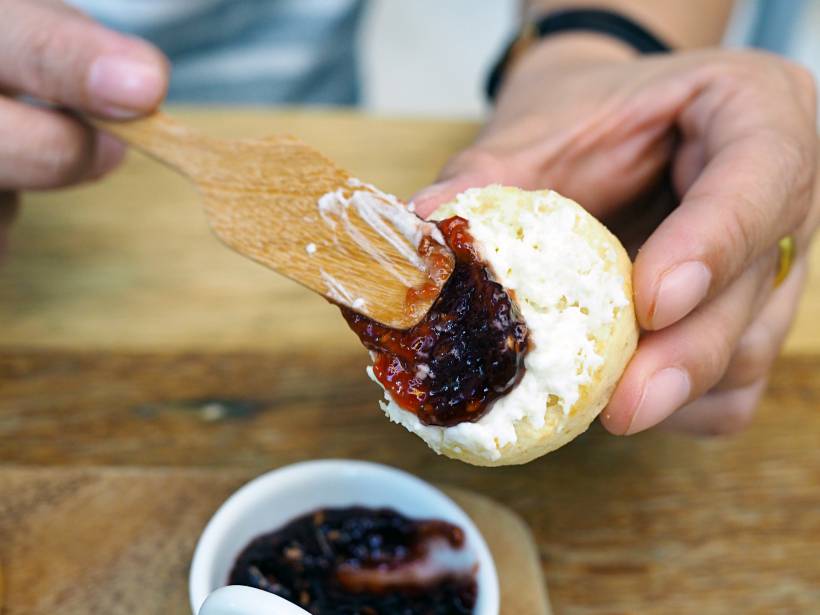
Should you put jam or cream first on scones? The answer to this question is what mainly separates the two types of cream teas. If you are eating scones the Devon way, the rule is to spread clotted cream before adding jam. Meanwhile, the Cornish way to eat scones involves slathering jam first, then clotted cream after.
In terms of clotted cream quality
In general, the varieties of clotted cream, a dairy product made from whole-fat cow’s milk, have a sweet and nutty flavour. But what is the difference between Cornish and Devon clotted cream? Despite having the same production process, there are dissimilarities between them due to a range of factors, including cow diet and environment. Clotted cream from Devon is smooth, while those produced in Cornwall have a rough and crystalline surface.
In terms of jam variety
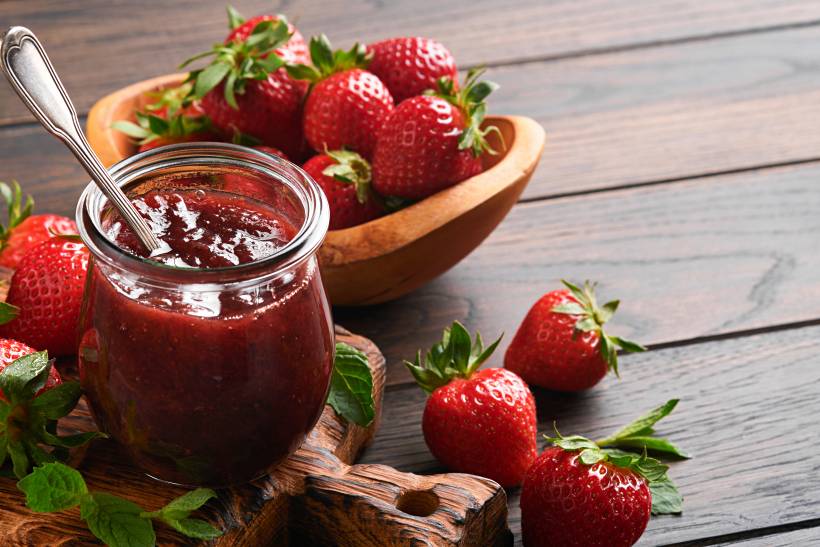
Strawberry is a favoured crop among farming businesses in both Devon and Cornwall. Several farms even offer strawberry picking tours to people visiting the area. It is, therefore, not surprising that people’s jam of choice—whether it’s for Devon or Cornish cream tea—is typically strawberry jam. On some occasions, blackcurrant and raspberry jams may also feature in Devon cream teas.
In terms of tea blend
The drink typically served during Devon or Cornish cream tea is black tea. Some famous black tea blends are English breakfast, Earl Grey, Darjeeling, and Assam. Note that neither type of cream tea—Devon vs Cornwall—dictates how much milk you should mix with your drink; you are free to add a mere splash or a generous amount. However, in line with the rules of etiquette, you should pour tea into a cup before adding milk.
In terms of presentation

There is not much difference between Devon and Cornwall cream tea in terms of presentation. Typically, the following dining wares and utensils need to be present: a teapot, spoons, cups, and saucers for the tea; small plates for the scones; separate ramekin dishes and spoons for the jam and clotted cream; and a milk jug. You may also wish to place your pastries on a cake stand for added flourish.
In terms of cultural significance
The earliest cream tea in recorded history occurred at Tavistock Abbey in Devon in the 11th century. Its popularity started to grow in 1662, thanks to Catherine de Braganza, wife of King Charles II. In the 1850s, the tradition became more known when tourists started flocking to the West Country, where both Devon and Cornwall are located.
Currently, with both counties having their own cream tea practices, the great cream tea debate still leads to different controversies, making some establishments assume the role of peacekeepers by choosing to promote both. The late Queen Elizabeth II, on the other hand, preferred the jam-before-cream order.
Enjoy the cream tea experience anytime through Airtasker
If you want to have a cream tea experience right at home, dessert delivery via Airtasker is the way to go. You can even have scones made the way you like them by connecting with a pastry chef.
Start the process by posting a task on the website, and then wait for Taskers to contact you.
Devon cream tea vs Cornish cream tea
| Devon Cream Tea |
Cornwall Cream Tea |
|
|
Scone Type |
Relatively denser |
Lighter than Devon’s scone |
|
Topping Order |
Cream before jam |
Jam before cream |
|
Clotted Cream Quality |
Thick and smooth |
Thick with a rough surface |
|
Jam Variety |
Typically strawberry jam but occasionally blackcurrant and raspberry |
Also customarily strawberry jam |
|
Tea Blend |
Usually black tea |
Also black tea |
|
Presentation |
Requires typical utensils and dining wares |
Uses the same dining wares and utensils |
|
Cultural Significance |
Said to have stemmed from Tavistock Abbey in the 11th century |
The late queen’s preferred way |
FAQs
Cream tea and afternoon tea are two different but related things. While the former only requires four elements—tea, scones, jam, and clotted cream—the latter involves more types of snacks. These include uncrusted finger sandwiches, petit fours, tarts, and cakes.
Using whipped cream instead of clotted cream is a cream tea no-no. If you can’t find clotted cream in your local grocery store, several dairy businesses have made it available on their websites.
The short answer is no. Clotted cream is made by heating whole-fat cow’s milk until it curdles. It has a 55% fat content and has been described as having a nutty taste. Mascarpone, also made by heating, has a hint of acidity thanks to tartaric acid. It has a 44% fat content.
Yes, you may drink other types of tea while having cream tea. Those that pair well with scones are chamomile and white tea.
Find dessert delivery, fast
Post a task